Hurricane Beryl’s Path and Trajectory

Hurricane beryl path tracker – Hurricane Beryl, a Category 4 storm, emerged from the Atlantic Ocean and has been traversing the Caribbean Sea. Its path is projected to continue northwest, potentially making landfall in Belize or Mexico’s Yucatan Peninsula.
Stay abreast of Hurricane Beryl’s path with real-time updates from WLWT Weather. Their expert meteorologists provide comprehensive coverage, keeping you informed of the storm’s trajectory and potential impact. Stay vigilant and monitor Hurricane Beryl’s progress through reliable sources like WLWT Weather.
The hurricane’s movement is primarily influenced by the prevailing easterly trade winds, which are guiding it westward. As it approaches land, it will encounter the Central American coastline, which may alter its trajectory slightly. Additionally, the interaction with landmasses can weaken the hurricane’s intensity.
As Hurricane Beryl continues to swirl towards the coast, it’s crucial to stay informed about its path. While there are numerous resources available for tracking hurricanes, it’s equally important to monitor tornado activity, especially since tornadoes can often accompany hurricanes.
To that end, we recommend visiting the tornado tracker for up-to-date information on potential tornadoes in the path of Hurricane Beryl. This resource provides real-time updates, helping you stay prepared and informed during this potentially hazardous weather event.
Projected Path and Intensity
According to the National Hurricane Center, Hurricane Beryl is expected to maintain its Category 4 strength as it approaches the coast. The projected path is depicted in the table below:
| Date | Time (UTC) | Latitude | Longitude | Intensity |
|---|---|---|---|---|
| July 5 | 00:00 | 17.5 N | 84.5 W | Category 4 |
| July 5 | 12:00 | 18.0 N | 85.0 W | Category 4 |
| July 6 | 00:00 | 18.5 N | 85.5 W | Category 4 |
| July 6 | 12:00 | 19.0 N | 86.0 W | Category 4 |
Potential Impacts and Hazards of Hurricane Beryl
Hurricane Beryl, with its potent winds and torrential rains, poses significant threats to coastal communities and inland areas alike. Its wrath can unleash a cascade of hazards, including:
Storm Surge
Storm surge, a wall of water pushed ashore by the hurricane’s force, is a major concern. It can inundate low-lying coastal areas, submerging homes, businesses, and infrastructure. The surge can penetrate far inland, exacerbating flooding and leaving behind a trail of destruction.
Flooding
Hurricane Beryl’s relentless rains can trigger widespread flooding, both along the coast and inland. Rivers and streams may overflow their banks, inundating homes, roads, and farmland. The combination of storm surge and inland flooding can create a perilous situation, isolating communities and disrupting essential services.
Wind Damage, Hurricane beryl path tracker
Hurricane Beryl’s howling winds can wreak havoc on buildings, power lines, and trees. High winds can tear apart roofs, shatter windows, and topple structures. They can also uproot trees, blocking roads and causing power outages.
Power Outages
Hurricane Beryl’s winds and flooding can damage power lines, causing widespread outages. These outages can disrupt communication, transportation, and essential services, leaving communities vulnerable and isolated.
Vulnerable Populations and Areas at High Risk
Coastal communities, particularly those in low-lying areas, are at the highest risk from Hurricane Beryl’s impacts. Inland areas near rivers and streams are also vulnerable to flooding. Elderly residents, young children, and those with disabilities may face additional challenges during a hurricane.
Mitigating Risks
To mitigate the risks posed by Hurricane Beryl, it is crucial to take precautionary measures:
– Residents in affected areas should heed evacuation orders and seek shelter in safe locations.
– Coastal communities should reinforce their infrastructure and implement flood protection systems.
– Power companies should prepare for outages and mobilize crews for rapid restoration.
– Emergency responders should be on standby to assist affected communities and provide essential services.
Preparedness and Response Measures for Hurricane Beryl: Hurricane Beryl Path Tracker

In the face of an approaching hurricane, meticulous preparation and prompt response are crucial for safeguarding lives and property. Individuals and communities in the path of Hurricane Beryl should take immediate action to ensure their safety and well-being.
Evacuation Plans
If an evacuation order is issued for your area, it is imperative to adhere to the instructions promptly. Identify designated evacuation routes and shelters in advance, and have a plan in place for transportation and accommodations. Stay informed about evacuation procedures and follow official updates from local authorities.
Emergency Kits
Assemble comprehensive emergency kits that include essential supplies for each household member. These kits should contain non-perishable food, water, first aid supplies, medications, a flashlight, batteries, a whistle, and important documents. Keep these kits readily accessible and consider storing them in waterproof containers.
Communication Strategies
Establish a communication plan to stay connected with family and friends during and after the hurricane. Identify multiple ways to communicate, such as cell phones, text messages, social media, and battery-powered radios. Charge all devices and have backup power sources available.
Role of Government Agencies and Emergency Responders
Government agencies and emergency responders play a vital role in preparing for and responding to hurricanes. They issue evacuation orders, provide emergency shelters, and coordinate rescue and recovery efforts. Stay informed about official announcements and follow instructions from these authorities.
Resources and Information
Numerous resources are available to stay informed and connected during Hurricane Beryl. Local news stations, weather services, and government websites provide up-to-date information on the storm’s path, intensity, and potential impacts. Social media platforms can also be used to share updates and connect with others in affected areas.